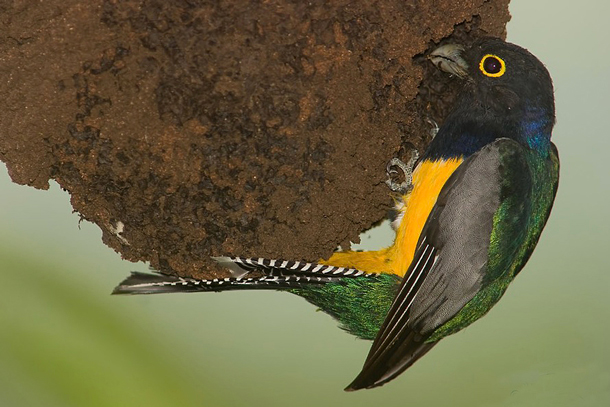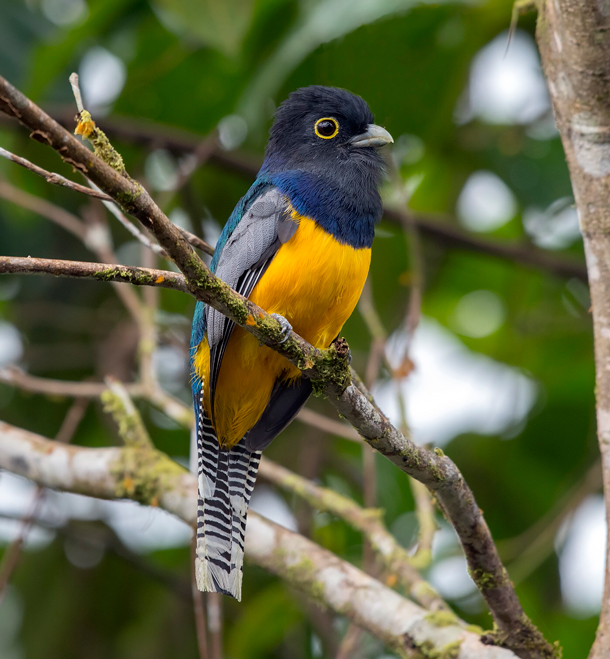BirdNote®: Trogons Nest with Wasps
Air Date: Week of April 3, 2020

Move in day! A Violaceous Trogon checks out a possible nest site, in a huge wasp’s nest. (Photo: © Greg Basco)
Have you ever liked a restaurant so much you thought you might want to move in? That’s what the Violaceous Trogon does. This striking iridescent green and yellow Central American bird will excavate a cavity for its nest in the midst of a huge wasp nest, snacking all the while. The wasps provide a tasty bit of protein, and a natural defense against the Trogon’s predators. BirdNote®’s Mary McCann has the story.
Transcript
CURWOOD: Well, they say home is where the heart is and to be safe at home Trogons take that need to an extreme. Here’s Bird Note’s Mary McCann.
BirdNote® Trogons Nest with Wasps

The striking iridescence of the trogon’s blue feathers is the result of back pigments arranged in a structure that reflects light in a very particular way. (Photo: Doug Greenburg, Flickr, CC BY-NC 2.0)
[Call of the Violaceous Trogon] When it comes time to nest, birds require a site that protects them, both from weather and from predators. Nests are perched high in trees, secreted deep in dense branches, or concealed in cavities. Some birds take a further step — nesting where they are defended by stinging insects.
The Violaceous Trogon (pronounced TRO-gahn) of the New World tropics often excavates its dwelling within a large, active wasps’ nest. [Violaceous Trogon call] The Violaceous Trogon is a striking bird, ten inches tall with a deep blue head and breast and bright yellow belly. It’s adept at catching insects, and it begins its work at the wasps’ nest by eating some of the wasps. A pair of trogons then digs a cavity within the massive nest, large enough to accommodate themselves and their eggs. [Violaceous Trogon call]

Trogon’s and their close relatives Quetzals are known for extravagantly colorful tail coverlets, the ordinarily small feathers which cover and protect the base of the tail. (Photo: Doug Greenburg, Flickr, CC BY-NC 2.0)
While they may continue to snack on resident wasps throughout nesting, the trogons never eliminate all the wasps. And they create a nest that few predators would dare disturb.
Some birds nest in large ant or termite colonies, too. Safety is where you find it.
###
Written by Bob Sundstrom
Call of the Violaceous Trogon provided by The Macaulay Library of Natural Sounds at the Cornell Lab of Ornithology, Ithaca, New York. Recorded by C.A. Marantz.
BirdNote’s theme music was composed and played by Nancy Rumbel and John Kessler.
Producer: John Kessler
Executive Producer: Chris Peterson
© 2016 Tune In to Nature.org January 2013/2018/2020 Narrator: Mary McCann
ID# 011507VITRKPLU VITR-01b
https://www.birdnote.org/show/trogons-nest-wasps
CURWOOD: For pictures buzz on over to the Living on Earth website, loe.org
Links
Read more on the BirdNote website
Click here to watch a video of the Violaceous Trogon in action
Living on Earth wants to hear from you!
Living on Earth
62 Calef Highway, Suite 212
Lee, NH 03861
Telephone: 617-287-4121
E-mail: comments@loe.org
Newsletter [Click here]
Donate to Living on Earth!
Living on Earth is an independent media program and relies entirely on contributions from listeners and institutions supporting public service. Please donate now to preserve an independent environmental voice.
NewsletterLiving on Earth offers a weekly delivery of the show's rundown to your mailbox. Sign up for our newsletter today!
 Sailors For The Sea: Be the change you want to sea.
Sailors For The Sea: Be the change you want to sea.
 The Grantham Foundation for the Protection of the Environment: Committed to protecting and improving the health of the global environment.
The Grantham Foundation for the Protection of the Environment: Committed to protecting and improving the health of the global environment.
 Contribute to Living on Earth and receive, as our gift to you, an archival print of one of Mark Seth Lender's extraordinary wildlife photographs. Follow the link to see Mark's current collection of photographs.
Contribute to Living on Earth and receive, as our gift to you, an archival print of one of Mark Seth Lender's extraordinary wildlife photographs. Follow the link to see Mark's current collection of photographs.
 Buy a signed copy of Mark Seth Lender's book Smeagull the Seagull & support Living on Earth
Buy a signed copy of Mark Seth Lender's book Smeagull the Seagull & support Living on Earth

